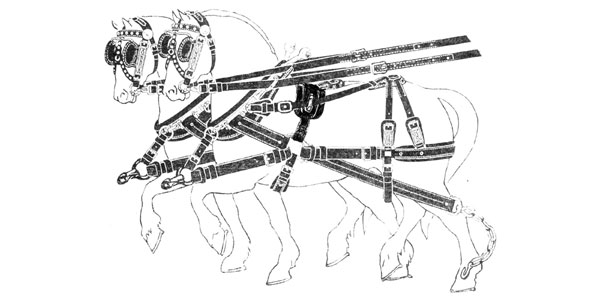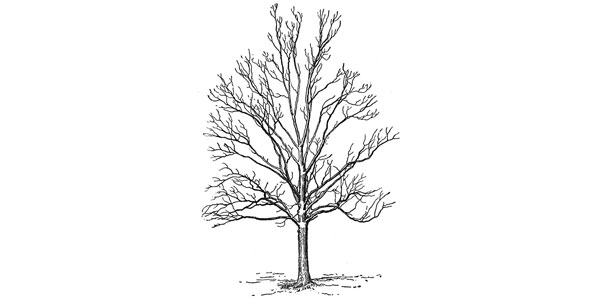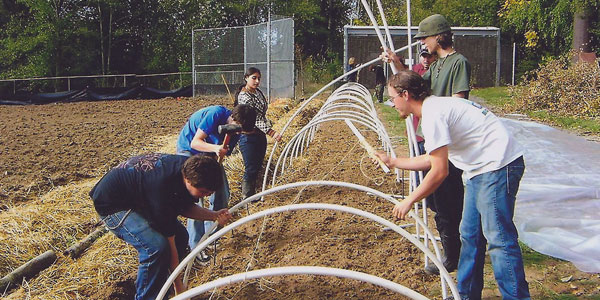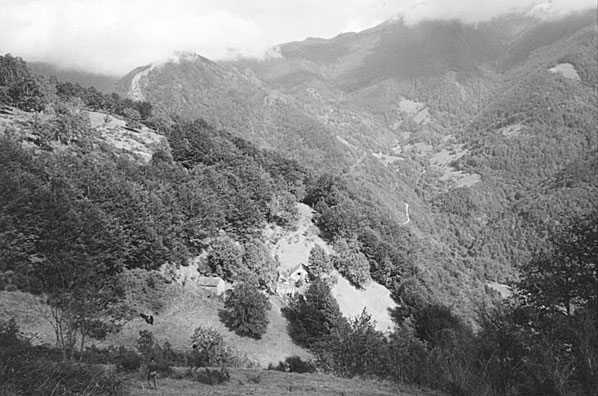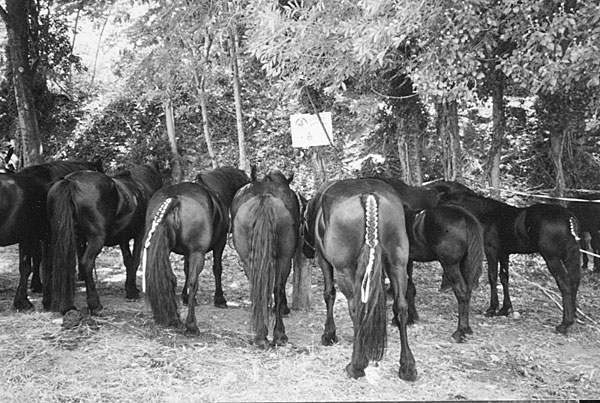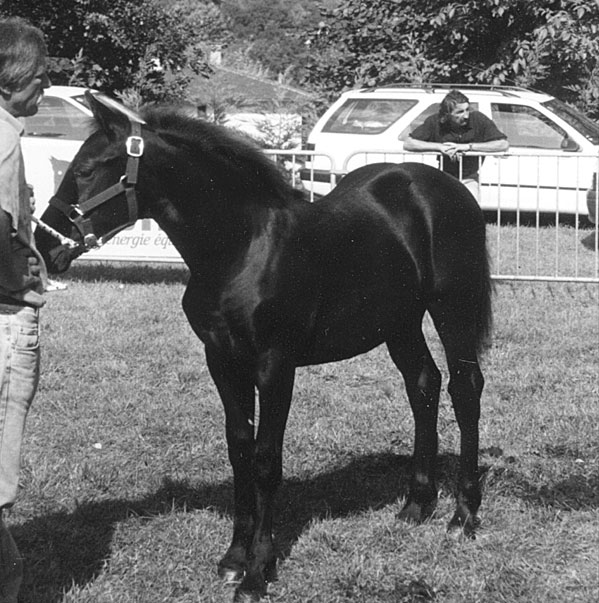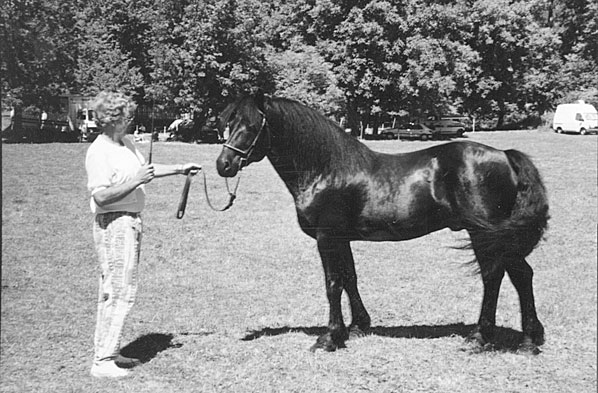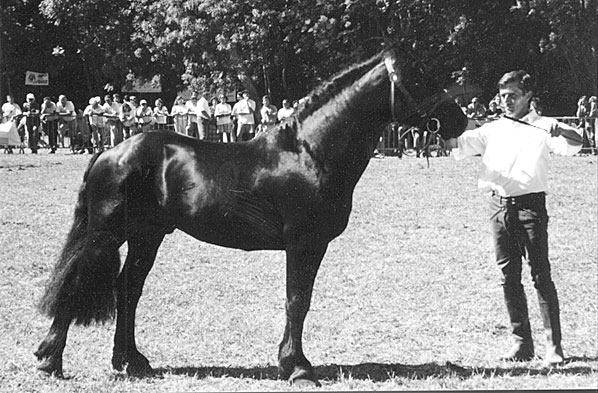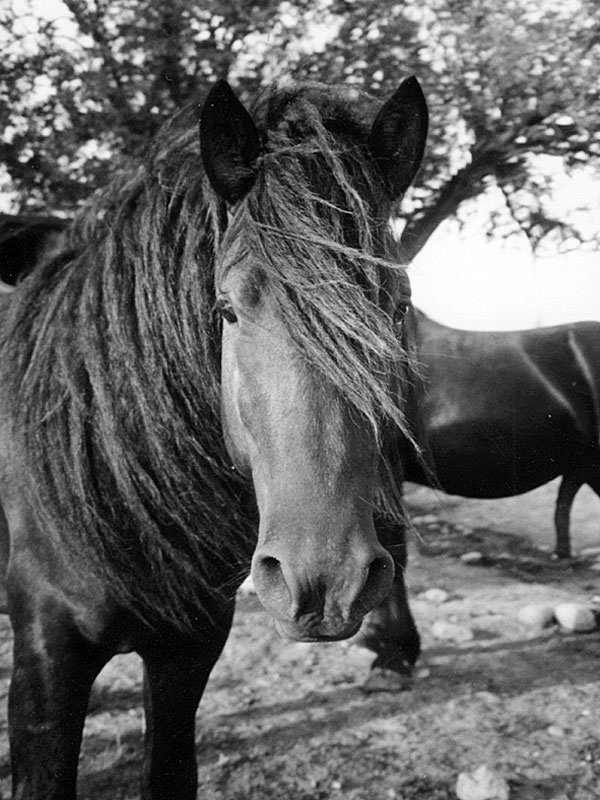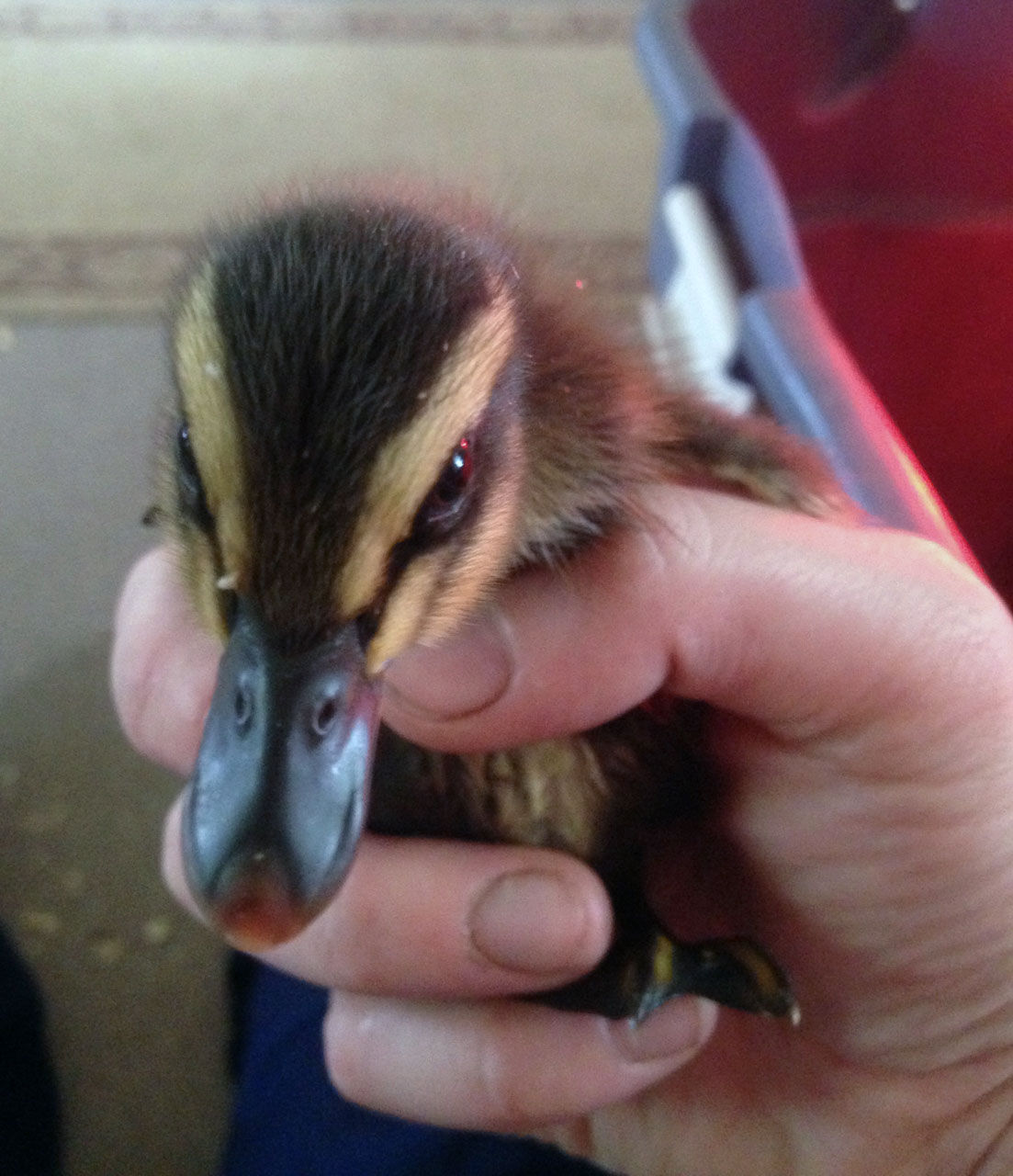Letters
Cheval de Merens Revisited
Cheval de Merens Revisited
An Obsession Driven Odyssey
by Mickie Proulx of Valdez, AK
Dear SFJ,
In the Fall ’97 issue of SFJ you printed an article on the Cheval de Merens, the all black horse of the French Pyrenees. I was immediately obsessed by their beautiful stature, a very strong draft-type-looking horse with powerful legs and long flowing manes and tails. The article sent me running for maps to locate France and the Ariege Valley, the central location for the Merens. After making contact with the writer of the article and being told of the major Merens horse show in August, plane reservations were made. How exciting to go see hundreds of these beauties first hand. We went to France solely to see the horses but France ended up being a great place to vacation with ancient castles, cathedrals, underground rivers and prehistoric caves.
Cheval de Merens means “horse of Merens.” Merens is a small village nestled in the Pyrenees Mountains and is the birthplace of the breed. To get to the Pyrenees Mountains you fly to Paris, there you can either drive south twelve hours or take a commuter plane to the city of Toulouse. In Toulouse you can rent a car and in an hour or so you’re in the mountains. The Pyrenees Mountains lie along the border of Spain, extending 270 miles and reaching 11,200 feet in height. It’s a beautiful area with many high meadows where most Merens are left to somewhat survive on their own.
The horse show is held every August and runs for seven days. The best mares with foals, one, two and three year olds are brought down from the mountains to compete. During the week the show is held in a different village daily. The best four or five horses in each class are selected to go to the three days of final showing in picturesque Boulan. What a way to see France!
Much emphasis is put on the mare and foal classes, where they are shown and judged as a pair. There are classes for best one-, two- and three-year-old fillies and colts, and classes for three year olds under saddle where the rider is not judged at all. The colts vie for points towards their “authorization.” Many strict exams must be passed before they can be recognized as a stud. It was refreshing to see the horses being judged without all the sterling silver and flashing American fashions that seem to take over the show rings in the U.S.A.
The weekend was exciting with trick riders, acrobatics, racing, driving, and a most impressive demonstration of the sure-footed Merens being ridden down steep, rocky embankments into the show grounds. A hearty group of Italians rode their Merens from Italy, over the Alps (about 500 miles), to join in the festivities. They were celebrating their country’s 20th anniversary of Merens ownership.
The show ground vendors offered great French cuisine, breads, wines, souvenirs and leather goods. To top off the Sunday show a baby Merens was raffled off.
We noticed the French to be very kind and hospitable. There are 5-Star Bed & Breakfast’s available in the Ariege. Soffie’s B&B, located right in Merens, has a view of the world. Ivan Quinquis’ B&B, in the village of Biert, offers trail rides where you can ride a Merens into the mountains.
The highlight of our trip was visiting “Helene’s Happy Horse Farm.” Owned and operated by Kevin Henshall & Helene Sapy. Their sprawling old French-style farm is in the farming village of Lafajole and surrounded by huge fields of sunflowers. Kevin took the time to introduce us to all fifty of his Merens horses, including his four stallions. They all had personalities! And gorgeous! We were able to watch Kevin work with his horses and ready his stallion, Galurin, for the show (he took Champion).
We discovered that Helene and Kevin have the reputation of being the top breeders of Merens. They were very patient with our inability to speak any French (they speak English). We inquired as to which horses were available for purchase and we had it narrowed down to a half dozen that we thought we should bring home with us. The prices of the horses are reasonable but the cost of airfare and quarantine … well, we had to leave them with Kevin for now.
There is only one Merens mare in the United States belonging to a lady in Oregon. How unfortunate for us Americans. Maybe someday we’ll be blessed with them here in the states.
Ahh … meanwhile, I’ll continue to dream of those versatile black mountain horses high in the Pyrenees.
Voila‘! Extraordinaire!!
Mickie Proulx
Valdez, AK
History with the Implement
Dear Lynn & staff:
I am very pleased with the magazine. I especially liked the article on the John Deere bridge trussed frame elevator. My grandpa and dad each had one. Grandpas was short, the tower and wheels up to the double corn crib. He had the wagon tower also, a long drive rod out aways to a Ford Model A transmission then on to a PTO shaft kinda coming off the ground to the 9N Ford. It had an open chain on the bottom of the hopper, as small grand children, we were often pushed back by grandma unloading ear corn. (Seven of us kids, mom and dad had us each year from 57-63, we stayed there while mama had another in the hospital – always in October, November, or December.) Dad’s elevator must have been a little later model, factory PTO, enclosed hopper, it was moved from oats in the grainery to wire ear corn cribs, we got to moving it, so much between cribs, daddy put a hay rope on each side at the top so to save time not lowering it, me and my brother each held on to the rope so it wouldn’t sway too much (narrow wheel tracks). My brother was born October 31, 1957, me November 3, 1958, sister December 22, 1959, sister December 5, 1960, sister November 13, 1961, sister October 31, 1962, sister October 16, 1963. So when the youngest sister had her birthday October 16 she was the same age as the next sister born October 31 for a couple weeks. Five sisters. Each birthday seemed to gain on the previous one. My mother would say, “I don’t see any of these young women trying that now days.” My uncle scrapped my grandpa’s elevator. My dad got a later “Meyer elevator,” low down hopper, rubber tires, took it to different farms and it worked real nice. I would like to find the whole thing, horse power, elevator, wagon elevator.
Well enough for now, keep up the good work.
Sincerely yours,
Eric Stout
Brighton, IA
Manage to Remain
The most recent edition I received, volume 41, issue 1, included a reprint of the McCormick Deering Primrose Cream Separator on page 27. I have this separator. Would you know where I might find replacement rubber rings to seal the bowl shell?
I have been sitting on the sidelines for awhile but I am thinking about getting a team again to handle gardening. I bought a 4 foot disk and replaced a 16 inch furrow bottom with a 14 inch bottom on a sulky plow. I also got a one section spring tooth harrow. These changes should permit field work with just one team of horses. I am in the process of obtaining parts to mount finger weeders on a one row horse cultivator for better weed control in planted rows.
Another project involves rebuilding an Aermotor windmill. I am learning more about wind mills that I never knew in the past. I manage to remain busy with projects.
Sincerely,
Dennis Havran
Milo, IA
Dennis, I was told someone had some for sale online through EBAY. I recommend you contact Hambry Dairy Supply, 2402 SW Waterstreet Rd, Maysville, MO 64469 ph 800-306-8937. Good Luck. LRM
Start with Service
Dear Lynn –
Thank you for a great article [soon to be a book] A Farm for Free. I was touched at a very deep level that you would offer such wise advice to anyone who will buck the trend of hi-tech and urban pleasures and venture into growing food for a living. Having read your online biographical experiences, I could see your life and your knowledge of other experiences woven into the text. The hopes, the disappointments, and everything in between. I’m sure it will give hope to many. Your advice to start as one who serves, who helps and seizes the moment is so right on. You are an important part of the renaissance of small farming. Keep going. May your farmers be blessed and your harness well kept.
Peace
Scott Eagan
Combermere, ON
LIFE
Often a ‘mixed bag’
life, holding hearty grain and bitter darnel
in the same sack, hard to separate
a package brightly wrapped, with cloud
and rain contained
we try to do our best, yes we do
and knowing that the mark is often missed
our Instructor points out our faults
and our successes, lovingly, gently, insistently
like a correction folded into a compliment
and not knowing who will sort it out
Teacher and student are left holding the bag.
Scott Eagan
6/23/17
Hello from Michigan!
Hello from Michigan!
Dear Lynn Miller and staff,
Hello from Michigan! We have only just started to read your journal, and have really enjoyed it. This is my first letter to the Journal, so please bear with me.
First off, thank you for your publication. It is always a special occasion when the journal arrives, my favorite part would have to be when the seasoned farmer imparts some knowledge. Seems like some of the so-called “Millenials” think that the farming techniques of yesterday have no use in the modern day, but there are those of us who are thirsty for knowledge of the way farming used to be. Sometimes I wonder if we lost so much more than we gained in the last 100 years, not only economically, but also morally. It’s so nice to see the references to the Good Lord in your journal as well.
Secondly, my dad is trying to figure out how to make a PTO forecart, but we are having difficulty finding information on people who have made their own, or what dimensions to make the cart out of and such. Also, if anyone has plans for a draft two wheel cart, plans for those seem to be as scarce as ground driven PTO cart plans!
A little about myself. I am 21 years old, and have lived on the same 20 acres my grandfather farmed, give or take a couple acres, (the dawdi haus had to be sold sadly). We have always had a few animals, including a nice, old team of Belgian Drafts. I help with gardening, and taking care of the livestock. I like to read, sew, bake, and am trying to convince the draft horses they should let me ride them. I’ve been working in my dad’s welding shop, as well as taking some classes for animal medicine. I am really interested in heritage breeds, especially silkie hens and Duroc hogs. Both of which do great in the mid-Michigan climate.
Thank you again for all the information and encouragement you guys print. May you guys continue to bless your readers for another 40 years.
Sincerely,
Amber Baker
Clarklake, MI
Hi Amber,
Thank you so much for the kind words. The country has definitely seen a resurgence of interest in small-scale, ecologically sound farming among young people such as yourself. Just yesterday, a young man named Devon stopped by our office in Sisters. He has been working on a biodynamic farm in California, and next week he is leaving for New York for another such position in a conscious effort to expand his knowledge on his path to owning his own farm. Young people like you and Devon give promise to the future.
Your question about forecarts inspired last Friday’s post featuring Basil Scarberry’s forecart plans. Ken Gies has also contributed his version of the ground-driven PTO forecart to SFJ.
Basil Scarberry’s Ground-Drive Forecart
Homemade Ground-Drive PTO Forecart by Ken Gies
I’m sure you and your Dad will find the instruction and inspiration to build your own. I really like how Basil used a 4-wheel drive hub for PTO engagement, but the simplicity and effectiveness of Ken’s scissor jack and belts can’t be denied. Ken also gives very valuable information on calculating and setting up the PTO RPMs.
As for a 2-wheel cart, I searched the website and found The Tip Cart by William Castle. Though on a smaller scale, A Pony-Powered Garden Cart by Jenifer Morrissey might spark some ideas. Lynn Miller’s Work Horse Handbook has plans for a nice non-ground-drive forecart that provides great visibility. As I move forward adding SFJ articles to the website, I will see what I can find for other styles of carts and put them up.
Thank you for your letter, Amber, it was great to hear from you.
– EG
Black Walnuts All ‘Round
Dear Lynn,
In the Summer 2014 SFJ there is an article by Glenn Dahlem about the black walnut (p. 62). If I may, there are a few additions I would like to make regarding using black walnuts. First, the harvesting. From what I read it’s best to gather the fallen nuts and hull them while the hulls are still green if you’d like to eat them, as apparently the resultant ‘dye’ from the hulls turning black bleeds into the nutmeat and imparts an unpalatable bitter flavor. I’ve not bothered trying to verify this, but that’s what I’ve read.
Second, regarding removing the hulls. An old-fashioned corn sheller is one option. I have an antique Blackhawk model that I picked up at a farm auction a couple years ago. It’s a fairly simple cast-iron hand-cranked affair and it has a tensioning spring adjusted by a thumbscrew on one side. It came mounted on a nice wooden box in such a way that, when shelling corn, the kernels fall in and the cobs are either ejected clear of the box or deposited into a nice pile in one corner. Unfortunately, hulling black walnuts isn’t quite so convenient. I have to manually dig through the contents of the box to pick out the nuts (in their shells) from the hulls. This is not a clean job, and not for those who dislike brown fingertips. I suspect the free-standing flywheel-operated corn shellers might work considerably better for hulling walnuts, but I have no firsthand experience there. (Those things go for an even higher price at auction, undoubtedly to be used as adornment for some city-dweller’s living room.)
A simpler way, if you’re not a stickler for tidiness, is to simply pile the walnuts up where they’ll be driven over frequently. This fall I piled them up at the edge of our driveway where I park my little truck so that I’d run over them fairly frequently. This won’t remove all the hulls, but it’s a lot less time consuming for the hulls it does remove.
If you’re planning on eating the nuts, the next step is to clean the in-shell nuts by putting them in a bucket and filling it with water. Jostle them around a bit, and discard the ones that float to the surface. (They float because the nut inside never fully developed, leaving a hollow space.) Because hulling is not a clean process, they’ll probably require a good bit of washing. Then leave them to dry on a wire rack. Supposedly leaving them until they have dried to the point that you can hear the nutmeat rattle inside the shell when shaken makes for the easiest nutmeat extraction.
I, however, feed my black walnuts to the chickens. I first heard this idea from a plain-living acquaintance who, I believe, roasts the nuts first. Why, I don’t know. Then I read an account in J. Russell Smith’s book “Tree Crops” about farmers in the Ozarks overwintering their laying hens on nothing but black walnuts and whatever the hens could forage. I have a wall-mounted black walnut cracker (this isn’t your average run-of-the-mill nutcracker; these are heavy-duty things, owing to the strength of the walnut shells), also picked up at auction, which I use occasionally, though I find it much easier to just lay the nuts on a hard surface such as a tree stump or a concrete block and crack them with a wooden mallet. You do have to watch out for hungry, inquisitive chicken heads, though. A metal hammer or mini-sledge works too, though they seem to smash the nutmeats too much. The chickens pick the nutmeats out, providing food and satisfying their need to peck. Last winter, I noticed a dramatic increase in the strength of the eggshells once I started feeding walnuts. My wife tells me that pregnant women consuming plenty of protein have strong amniotic sacs as well. Evidently there’s a correlation there.
I was going to be clever and write about how much more economical it is to feed walnuts to chickens than to sell them to the walnut buyers, but turns out that’s not the case. Prices at the buying stations were high this year, in the ballpark of $14 per cwt, de-hulled. With the nutmeat constituting around 14 % of the de-hulled nuts (based on an entirely unscientific study of mine), this comes out to a payment of $1.00/lb. for the nutmeats. By comparison, current non- GMO chicken feed at the local mill is in the ballpark of $0.30/lb. So this year I could have sold, say, 42 lb. of edible nutmeats (300 lb. of de-hulled nuts) for $42.00 (3 cwt at $14/cwt) and then purchased 140 lb. of chicken feed with that money. By keeping the walnuts on farm and feeding them, however, I do save a trip to the buying station, as well as a trip to the feed store. I also retain the economic value of the hulls and shells (as described in the above-mentioned article, or simply as fertilizer) and I get a fresher feed product to boot. What’s the price of more self-sufficiency and better feed? And, hey, if I really wanted to maximize the price received on black walnuts, I could always try my hand at direct marketing, since there is obviously a market for them.
I said I feed the walnuts to my chickens, and that’s mostly true, but I apparently feed them to a couple of squirrels at the same time. I have unintentionally fattened at least two red squirrels, who seem to spend their days running across shed roofs, climbing down to the walnut pile, them scampering back up the maple trees in the yard to feast. They’re easy targets should I want to ‘harvest’ them, but I can’t quite bring myself to. It’s too easy and seems perhaps a bit unsporting.
On a different note, please continue printing “The Farming Ladder” in SFJ. I don’t know if you’re taking yes or no votes, but if so tally another on the yes side. Apparently I’m an Anglophile at heart, because I find I always enjoy reading English farming books and articles, so the more the merrier in my opinion. I also want to simply thank you for all that SFJ is. My Fall 2014 copy came in the mail on Christmas Eve, and I promptly told my wife that she was on her own for the rest of the holiday preparations because I had a Small Farmers Journal to read. (That wasn’t the case, though we both stole bits of reading here and there over the next couple of days.) While the other farm publications I read are purely of the practical sort, SFJ manages to touch the intangible beauty of farming, and I always come away inspired and refreshed.
While I’m writing, I’d also like to make a request of your readers. I’d love to see more articles about specific farms and farmers. Who are they, and where do they farm? What do they produce, and how and why do they produce it? Where do they sell, and how do they market their products? What production and marketing challenges do they face? What is the seasonality of their farm work? Photos are great. If they’re not keen on writing about themselves, they can write about other farms and farmers they know. Practical, how-to information is always useful, but is of necessity a broad-net approach and the particulars will necessarily vary from farm to farm and from farmer to farmer. That, I think, is the benefit of stories about particular farms and farmers over general how-to articles. I, at least, find that there is much greater value in what real farmers are doing on real farms than in what a “typical” farmer is theoretically doing on a “typical” farm, as I feel like I can more readily adapt the real-life scenarios to my own situation. So, fellow readers, please give consideration to telling the rest of us about your farm, or about a particular aspect of your farm that you think others might find useful.
Thanks again, Lynn, for a great publication.
Wes Hunter
Providence Farm
Seymour, MO
Keep ‘Em Coming
Super magazine, Lynn and Kristi!!
I love the content, and I can’t wait for the next issue in my mailbox.
My best to you.
Bob Langness
Broomfield, CO
A Large Part
Mr Miller –
My name is George Bristol. I served for 38 years on active duty in the United States Marine Corps. I retired in August 2013 as a Colonel and am still working in special operations overseas. I am writing to tell you how much I enjoy and support your efforts with SFJ. I greatly enjoy every issue and have now read OLD MAN FARMING and GLASS HORSE and recently ordered WHY FARM and THOUGHT SMALL. Sir, you are a gifted writer indeed.
For me, I have always hoped that – in the 64 months I had in combat, getting wounded, and serving 19 of 38 years overseas – I was doing a small part in protecting the American Dream. In your writings, I get a clear picture of what it is: hard work, independence, perseverance, and a sense of humor and love for the land.
Sir, you have a subscriber for life in this old leatherneck. I thank you.
Semper Fidelis,
George Bristol
Woodbridge, VA
Dear Colonel Bristol,
I, indeed we all, salute you for your service and sacrifice.
My father also served as a First Sergeant in the Marines during WWII (South Pacific). A short time before he passed away at almost 95, I was with him on Veteran’s Day when he insisted on leaving his nursing home bed to stand curbside for a small parade. There was a tear in his eye as he saluted those young servicemen who marched by. Enough said, or perhaps better put, there is too much needs said. We are deeply honored to count you amongst our reader family.
Lynn Miller
Looking For a Young Woman To Write To
Dear Lynn and Staff;
I want to first off tell you all how much I appreciate your Journal, at times your Journal is that little piece of sanity that keeps me going in this insane world. I always look forward to it coming in the mail, it’s like four extra Christmas presents each year. I am always delighted to open the first page to see what is written. You never disappoint, even your rants Lynn, so thank you. Keep up the good work, and don’t change a thing. My folks and I wanted to tell you that we really enjoyed awhile back Mr. Richard Douglass’ article on self-sufficient living. Mom likes to re-read it ever so often for its words of encouragement. I really enjoyed the latest excerpt, “Loving the Land,” if people learned to work with the land and take care of it, instead of against it there might just be fewer headaches. That’s a big “might.”
Well the reason why I’m writing other than to tell you, “Thank you,” is that my folks thought it would be good if I would write you all, in hopes that you could put it out in the Small Farmer’s Journal universe that I am looking for a young woman to write to. The thought was that you all and your readership were probably of like mind. So it would be a good place to try. I guess I need to say a little about myself. I’m 29 years old, grew up mainly on an eleven acre farm, surrounded by animals: goats, sheep, chickens. My family would put in a garden each year and try to raise what was needed. I love being around animals and I had for awhile a Morgan mare that I would plow our gardens with. I enjoy being outside. I like to hunt, garden, cut my own firewood, and make maple syrup.
Generally, I like to work with my own hands. I currently live outside Rich Hill, MO in an old house built in the 1800s which I’m fixing up. With the house I have two acres. It’s not much, but I believe in working with what you have and making do. I hope to someday have more land to work with. On the place, I have chickens, guineas, and ducks. I’ve started working with heritage hogs on a small scale. I’m starting out with a Gloustershire Old Spot boar and Duroc cross gilts. I put in my first garden last spring. I like the idea of being or becoming self sufficient, although I do work outside the farm for an income. I’ve worked in heating and air for the past seven years.
I’m looking for a farm girl around my age who is smart, energetic, loves animals, and is or sees herself as being self-sufficient, or wants to be. And who would like to write to a single man from Rich Hill, MO. I’m looking for a girl who can do more than work her thumbs, a girl who likes using her hands. I’ve thought about using a dating website, but I don’t like the idea of it, it seems so artificial. How is it that the main way of finding love has become reliant on a box made of plastic and wires, spilling out ones and zeroes to find a match. Whatever happened to the community social and get togethers? So, that’s what I am looking for. If you could put it out there I would greatly appreciate it. Thank you.
Again, keep up the good work.
Sincerely,
Peter Francis
1428 SW State Rt A, Rich Hill, MO 64779
Dear Peter and all other readers of SFJ, past time for a change in policy.
Many has been the time, over our 39 years, that folks have asked us to publish letters like Peter’s (above) and we have respectfully declined concerned about getting ourselves and our readers in trouble and embarrassing situations.
Times have changed, and are continuing to change, in remarkable ways. So we are allowing tasteful, proper, decent individual efforts to ‘connect’ through the pages of this journal. That said, I personally hold to my rights as editor to decline to publish any request to communicate which is tied to or dependent on social networking via the internet. (Don’t ask; trust it, you don’t want me to go on another tirade about the moral insolvency of social networking. Talk about finding love in all the wrong places!) So long as you are willing to reach out by mailing us an old-fashioned letter and requesting that certain others ‘mail a genuine letter’ back to you, we’ll make an effort to include your correspondence. After all, Peter is right by inference; each issue of SFJ is a community social or get-together. It’s our job to allow that to expand. And the way we do that is by getting out of the way. So send us your requests for pen-pals and we’ll see how things progress.
LRM
Worthy
Dear SFJ folks,
Thank you for creating a beautiful journal, worthy of a quiet room, cup of tea, and an evening of pleasant edification.
Warmly,
Lisa Douglas
Bishop, GA
Oh My, But…
Hello to all the good Folks at SFJ
I have had the privilege of receiving your fine magazine for about the last thirty years, and have now come to a point in life where I have to do some downsizing. Have too many irons in the fire and plan to concentrate the next few years the Lord might grant me in wood working.
Am sending a check for $70 asking that you supply a subscription to a few young, needy, future farmers. Through schools or direct, you decide. For a young farmer, there is no better document to be read, consumed, digested, and applied.
I also have about 98% of all the back issues if anyone wants to come to my farm and pick them up. I started sometime in the early 80’s and it’s been a year since my subscription ran out. Have enjoyed every issue and have learned a lot.
Thank you again for the years of education, support and some great thought provoking articles. And I do thank the Lord for your bold position, please keep up the great work.
Sincerely,
Alan J. Wilson
Cleveland, WI
On The Box
Keep it up! The world needs your voice.
April Jones
Ridgefield, WA
An Adroit Fan?
Dear SFJ,
Boswell is back! Just can’t keep a good man down. Even the Gospels have a line or two of humor. The rest must’ve been edited out, eh? Still a wonderful magazine. Still read it cover to cover. Still the best thing in the mailbox. Thank you for all the work everyone does to keep it that way.
Yours,
Katy Sweeney
Smyrna, NY
Who To?
Please continue my subscription where it left off. The articles, about driving, harnessing, working horses and breaking them, interest me most.
I do agree with your articles, about the direction that this country is going, the wrong direction.
Thanks,
Steve Widmer
Lasueur, MN
Discoveries
Hi,
I have lived my entire life of 48 years on the same small farm near Cedar Rapids, IA, however, horse farming is new to me. For Christmas this year I got several books on horse farming, including “Horsedrawn Plows and Plowing” by L.R. Miller. I enjoy it a great deal!!
Thanks,
Todd Stallman
Cedar Rapids, IA
Reciprocal Lubrication
Dear Lynn R. Miller,
First me let begin by introducing myself. My name is Whitley R. Bradberry. I “fell-into” your journal in a most interesting way many years ago and here’s the story: A friend from college came and stayed with me while on his long journey to a large city near us to seek medical treatment for ailments long-ago suffered from a terrible horse-riding accident that occurred while he was riding a horse in an English Riding class at the college we both attended. He was permanently disabled because of that terrible accident. I had already befriended him before his accident but once he returned to campus from the accident I went out of my way and assisted him in his recovery of learning to walk and talk again as his Resident Assistant and then Resident Director at the residence halls that we lived in. He loved horses before the accident and even more so after. However, his physical disabilities limited his abilities to ride and handle horses to many employer’s satisfaction because his movements were so much slower than normal. So he drifted from many a low-paying job to the next. He did get the opportunity to work for some outfits that used heavy horses during the winter to pull sleighs for sleighrides. He loved it but bosses or owners usually didn’t see his slow-magic with the horses. He has a way with horses, I believe, that existed because of his accident and permanent disability, because he did things slow! Anyhow, in this time and age, and possibly throughout time “slow” is not usually a favorable or hirable trait or quality. It saddened me to see him suffer financially because of government restrictions on earnings so that he could qualify for a very small amount of disability and then see the wind knocked out of his sails at the loss of a job working with the animals he loved. So, I often stayed in-touch with him throughout the years.
During his visit to obtain medical help for his ailments I asked him what he would do for work if money was not an object. He informed me that he would work with heavy horses. Because he loved them! I encouraged him not to give up hope of that opportunity and I also asked him if he read any good books or literature on the subject of working with the heavy horse. He did respond to my reading question and one of the referenced readings was the Small Farmers Journal and your writings. I didn’t pay much attention to what he mentioned at the time and honestly was desiring and trying to help him land a decent job and secure a better quality of life. His time with us ended and we parted. Much to my surprise, several months later, he gifted me for my birthday with a one year subscription to the SFJ out of his very limited wages. Truly a sacrifice!
Honestly, I didn’t know what the SFJ was but it didn’t take long and I fell in love with it. And, in doing so my dear friend has revolutionized my life! I love the journal, love what it stands for (and what it stands against!), and love its priceless community – though I actually don’t know anyone. I have subscribed ever since! I bought subscriptions for my parents, my former high-school library and a multiyear one for myself. Interestingly, I am not a small farmer!… yet…but hoping someday that that prayer will be answered with a “Yes!” and maybe my dream will be satisfied. I am not interested in it for financial profit but for the satisfaction of soul in a personal desire and dream of being a good husband of the land! For I personally believe the dividends that are yielded by the good husbandry of the land are incalcuable. I hold those of you who are doing so to the highest of honor!
I am the husband of the most beautiful and wonderful wife and we have been blessed beyond words with 6 beautiful children! Our oldest son was diagnosed with Insulin Dependent Diabetes Mellitus (Type 1 Diabetes) at the age of 3 (over 10 years ago) and I have engaged in natural, organic gardening and relish in the opportunity to “change the world” as Stephen Scott wrote about in his editorial Spring 2014 (even if it is just ourselves and our son!). We see wonderful and positive affects in all of us but especially our oldest son in eating fresh vegetables grown without any chemical applications!
But, I didn’t write all this to talk about me, my family, and my personal dreams and ambitions. I wrote to talk about you! I think you are incredibly wonderful Mr. Miller! You have an incredible gift with words! Yes, sometimes they are difficult and sometimes I do not agree with you but you have gift and a way with words! I believe strongly that all communities throughout society need desperately “Town Criers” like you! Especially on this subject of which you cherish very much – small farming and its vitality to humankind! Your a champion to me! A much needed champion. And, from the ‘letters’ to the SFJ throughout the years I have read it appears you are a champion to a host of others as well! Oh, there’s a sourpuss every once in a while but I beg of you to keep it up. I also agree with Mr. Schlabach of Millersburg, OH, “Don’t let Ryan Foxley slip away…” He’s another champion in my book along with many other of the contributors!
I was personally charged and challenged by a little something that appeared on the cover of the Fall 2014 SFJ which reads, “Good Work Is Lubricated By Appreciation!” I realized I had not ever taken the time to inform you how much I appreciate you. And, also by the optimistic blurb in same issue about Ed from Michigan who just turned 108 and called to renew his subscription for another two years!!! That’s absolutely AWESOME!!!
So, it is because of these things along with the notice in the mail of the upcoming expiration of my 5 year subscription that I wrote. I also wrote because I went to the SFJ website to inquire of the price of a Lifetime subscription and couldn’t find the answer. I have been entertaining that idea, possibility, and option because of the conviction inspired by Ed from Michigan. So, do you offer Lifetime subscriptions? If you do would you please inform me of the price of one? Just might have to have one…
Thanks for all you’ve done! All you’re doing! And all you’re going to do for small farmers!
Sincerely,
Whitley R. Bradberry, Snyder, TX
Dear Mr. Bradberry,
Thank you for your kind and generous letter. I have decided that I will accept for Lifetime Subscriptions, in trade, any sound breeding age cow, feeder steer, draft colt, cultipacker, two-hundred pounds of heirloom alfalfa seed, and/or equivalent money. I will not accept stock certificates in Google, Facebook, Amazon, Monsanto, or Smithfield Pork as I am certain they will not be around much longer. (Or at least not as long as we will.)
LRM
Voices Shared
Dearest Lynn,
Thank you for all you continue to do! I for one love your rants/passionate writing. As for those of us who feel the same, you give us a voice. You speak for the many who don’t have a voice in this culture but are being completely affected by all this craziness. S.F.J. is a labor of love and everything inside it is all about hope and moving towards a better world. Keep at it and sharing straight from the heart. We are complex beings and need to be able to express how difficult it is to live in these very insane times. Your voice is heard and needed and I thank you.
Have a great winter.
Ricky Baruc –Seeds of Solidarity Education Center
Orange, MA
Small Farming in the City
The Journal Staff;
The Barnyard Manure article on page 42 of the fall 2014 issue of the Small Farmer’s Journal was helpful in prompting me to action in enhancing the soil in our prolific three small raised vegetable beds here, in the middle of the city. After 8 years of a certain mulching tradition before our late spring planting the soil in the beds had become very sandy, with insufficient moisture retention for my irrigation abilities and thus for the happiness of Blue Lake bean and Sweet Success cucumber vines. I got creative with the chicken compost and put it on top of an impressive blanket of all leaves and anticipate digging it all with improved moisture retention as a result. I also am installing a fine antique tractor seat as a sculptural element next to the vegetable beds. Don’t laugh. I think there was subliminal influence from the fascinating antique graphics which are a regular feature of your magazine.
On June 7, the small landscape that surrounds my small house, created with exclusively NW native trees, shrubs, perennials and annuals and bulbs will be one of 6 gardens on a fund raising garden tour for the city symphony guild. Ticket sales gets close to 1,000 so, whatever the weather…. I can anticipate countless footsteps on my stepping stones and log rounds and the gravel path past the vegetable beds and tractor seat. The vegetable garden will be barely started by then but I am betting a lot on the manure and leaves… and tractor seat for ticket holders’ satisfaction along with my lush landscape. This whole property is herbicide/pesticide/insecticide free and totally bird/pollinator/butterfly friendly. Your publication’s emphasis here is appreciated.
Randall Speck
Eugene, OR
P.S. Some full-time jobs come with no paycheck. Care-giving for family members of senior status is one of those jobs and that is what I am doing now. And small farming… in the city. Our folks always have.
Here’s The Latest Buzz
Have you heard the buzz about an Educational Apiary in Central Oregon?
One small Crook County farm will be host to honey bee enthusiasts from the High Desert region this spring when it becomes the venue for a 3-season beekeeping education series presented by the Prineville Honey Bee Mentoring Partnership. A new year always means new projects on the farm, and SmudgieGoose Farm of O’Neil is no exception. 2015 marks an important milestone for this growing organic enterprise as it takes a big step toward achieving its goal of becoming an educational farm.
Owner Rob Dellenback and his partner purchased the farm in 2012 with a plan to develop a sustainable organic farm for the purpose of teaching others how to get back to the land. They planted 4.5 acres of open-pollinated, organic heirloom vegetable seeds in over 100 varieties for their first production season, offering fresh, local produce to the public at their on-farm Produce Stand and local farmer’s markets.
They started keeping bees with their first crop in 2013, after many months of research, and soon learned there was no end to learning about their busy new livestock.
Their second production season found them adding more bees as they expanded their produce selection to include over 160 varieties and began serving CSA Members, as well as marketing their abundance at local markets in Central Oregon.
As their interest in bees as a vital component of organic vegetable farming expanded beyond pollination and the sweet rewards of honey production, they wanted to learn what they could do to promote the role of these essential pollinators in a healthy, sustainable ecosystem.
They found a source for the answers they sought in Naomi Price and Richard Nichols of the Prineville Honey Bee Mentoring Partnership, with input from the Oregon State University Honey Bee Research Laboratory.
The farmers learned through the 2014 season that their new mentors shared their view of honey bees as a key element in the environment, as well as willing producers of honey, beeswax and other hive products. They also found that Price and Nichols supported their commitment to keeping things local.
After starting with “packaged bees” from California – and suffering a firstseason winter colony loss – Dellenback had acquired a feral hive from a nearby beekeeper, and noticed an immediate difference. The local “wild” bees were well adapted to the capricious seasonal weather of the high desert and resistant to most of the parasites that infest honey bee colonies. They produced exceptional queen bees for expanding the apiary, and remained strong against attack from other insects attempting to rob the hive.
Dellenback began to wonder why beekeepers in Central Oregon were not propagating new colonies from local stock with genetically local queens. Price and Nichols were already on the case, intent on organizing their local group to do just that; but they needed a place to conduct an education program to facilitate their ideas.
SmudgieGoose Farm enthusiastically accepted their invitation to become an educational apiary for the Mentoring Partnership, who are committed to raising only local bees. Dellenback and the mentors are very excited about the upcoming season of learning and cooperation.
SmudgieGoose Farm is located in O’Neil, Oregon. Rob Dellenback can be reached at smudgiegoosefarm@gmail.com or through his website at smudgiegoosefarm.com.
R. Dellenback
Oneil, OR
Multi-generational
Dear Lynn and Miller Family.
Thank you for all the hard work you do to keep SFJ going, and to practice and promote small farming. It is truly a labor of love, for both family and the land. Far more than a “job” or “career”, it is a lifestyle, one that requires daily wholehearted commitment.
We, as a multi-generational farming family, also share in this endeavor. Gardening, farming, and raising Heritage breeds while practicing a simpler daily life provides us with the opportunity to harvest wholesome foods, enjoy a healthy life, (albeit a hard-working one), and take care of our planet in a small way.
Although the efforts and accomplishments of an individual may seem insignificant, when combined with those of many like-minded others, we can and do make a difference. To all those hard-working fellow farmers out there, I say, “Thank you”! Don’t give up, know that you are appreciated, and your work is valued.
Cheerfully yours,
Kat Zapel
Moxee WA
P.S. Thank you for holding fast and refusing to go “corporate/mass media/mainstream.” Our way is the better way.
Parallelitis
Hi there young fella,
Thought I would write you a few lines after reading “Old Man Farming.”
Well, I am just a year and a half from being “80” – wow, how did that happen. I guess I was not paying attention.
You might recall me, from your editorial of many years back about not giving up the farm, and keep going. Our most recent contact was the exchange of poetry writings and the grand picture of the “old man” tree looking over the vineyard.
I hope you can read my writing – eyes going, etc. I just got finished with six weeks of the most barbaric medical treatment around – six weeks of radiation for cancer. Good thing it was with the VA, cost wise. Well they got the cancer knocked down, but the months of recovery are really, really tough. I needed to read something so I got a copy written by a young farmer from Sisters, OR.
We are on the same page Lynn, but I see things getting much worse.
The whole cancer thing I do believe started from my tenure in the raisin vineyards of California; much spray and chemicals. One of the worst things was the fact that the vines were in the fields next to cotton fields. They used all the really nasty sprays including defoliants which drifted over and actually took the leaves off, but the grapes were picked anyway for raisins.
There again is another example of how the USDA labels mean nothing, because under pressure of the big guys, they allowed the change in feed labels – from corn, oats, soy, to processed grain products – processed grain by products, etc. none of which I know what they are. I asked a salesman if cotton seed meal was a processed by product and he said yes. When I said they were probably the most sprayed crop around he said he did not know – go online and look at our website. It’s hard to find an honest feed label.
Any way I have been lucky in this life to have been able to farm in what I call “The Golden Era” of this country before “Get Big or Get Out” took hold. Not bad for a kid from New York City who got out of the army, met this sweet heart from Brooklyn, and 57 years and several farms later, find our life has been free and rewarding.
I would love to get back into a small farm again – we have 12 acres now, but only a few would be tillable and we live between two hills that block the sun all winter.
I loved your words about the sheep herders and the big flocks. When I rode for Uritea Ranch in the foothills of the mountains in California, I met a few retired herders who told wonderful stories of those days. Their dogs still spent a lot of time outside the feed lot herding the cattle inside to keep in shape.
The farm has some powerful memories, for me and my five kids. One son posted on Facebook how great it was to get lost in the many adventures, and the fact that mom would always know they would show up for lunch. My oldest son gave me a picture to carry in my mind when he and the one armed farmer he was helping came in the kitchen for lunch and without a word, unzipped his jacket, helped him off with it and three hands went into the sink and he washed all three up. Good stuff.
The saddest of all my life was the day I sold the team. It broke my heart and has left mental scars that will last my lifetime.
I agree with you all the way, that this country is going down. It’s all about greed and the fact that we are governed by crooks.
I am a bit less optimistic then you when you say more small farms would cure a lot of the problem because we must feed the people.
Why the heck do we have almost 9 billion people – hello folks – wake up.
Nature controls all that is within it, everything but one – sorry people – but then again that is wrong because we are going down swirly the drain.
You said those folk need food and we can provide it. Well when it all comes down and they have no income and have to feed the family they will be coming out to the small farms and taking what they need, including the breeding stock, the seed stocks, and even the houses.
This new generation with a phone stuck in their face don’t have a clue.
Well, I have bent your ear enough – keep up the fight. I would give most anything to be back on a small farm, I guess that’s why I buy a couple of lottery tickets each week.
I think I would like Oregon. Sweet Home sounds nice. I would love to go out with a set of lines in my hands. I know the team would just wait for someone to find us.
Farming is the only sanity left for me – doing nothing will take me sooner than anything else.
Keep up the fight Lynn. It’s good to see you and Kristi fighting the good fight.
In 1976 when you started the Journal I remember driving my team with a covered wagon for the Centennial. Good fun.
Best regards and wishes. Jane says, “Hi.”
Bob Faller
Republic, WA

